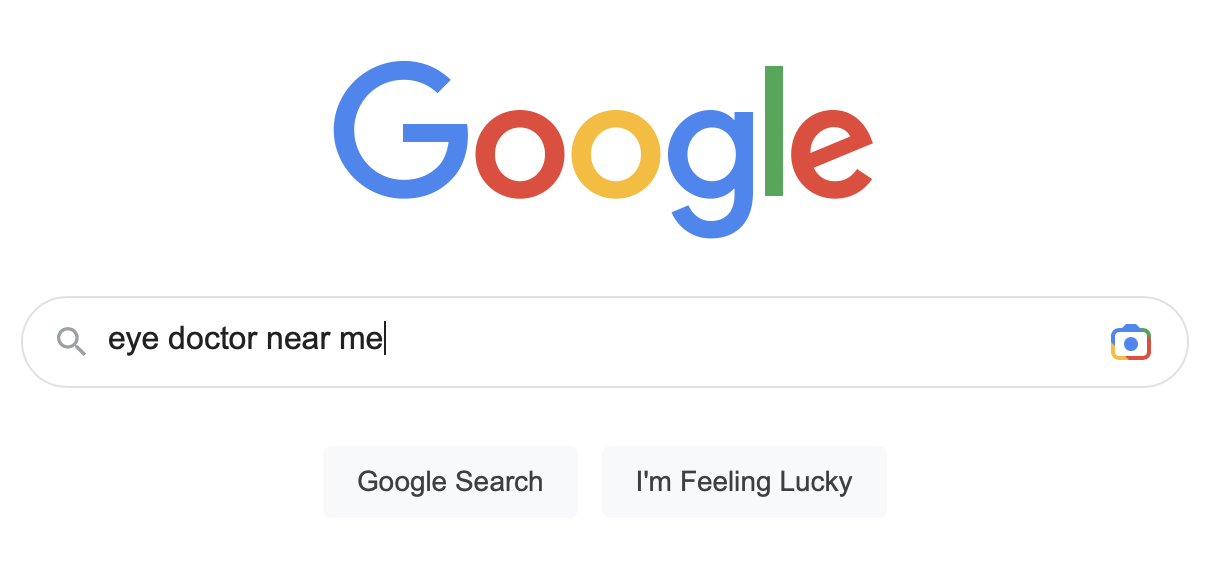 |
|
Ophthalmologists argue that as the optometric scope of practice expands around the country, there is a need for the profession to represent and differentiate itself from other eyecare providers online. Photo: Google. |
When searching for a new physician, most people rely on Google to provide a list of local recommendations. In a new study published in JAMA Ophthalmology, a research team consisting of mostly ophthalmologists found that when a person searches Google for local eye doctors, the results underrepresent ophthalmologists relative to the actual proportion who practice in a given region.1 Ophthalmologists argue that there’s a need to use search engine optimization (SEO) to gain better representation online, as well as a need to educate the public on the distinction between ODs and MDs.
The population-based cross-sectional study used a program to search the phrase “eye doctor near me” from the center coordinates of every county in the United States (n=2,955). Results of the top 10 websites and three Google map links were recorded. Data from the US Centers for Medicare and Medicaid Services was used to estimate the real number of both optometrists and ophthalmologists in each US county.
The researchers reported that “the national Google proportion of MDs was 4,727 of 16,345 (28.9%), which was less than the mean real proportion of MDs (15,778 of 41,975 [37.6%]).”1 They noted that the underrepresentation of MDs was apparent in 33 of 52 states/territories and 68.7% of counties nationwide. Additionally, in 76.6% of counties, they wrote that “there was a higher mean number of Google ODs than Google MDs.”
The univariate analysis, but not the multivariate analysis, showed an association between absolute MD underrepresentation and Latino ethnicity and below-poverty level.
A secondary outcome of the study was mean Google ratings and reviews for counties where the mean number of Google MDs was more than that of Google ODs compared with when it was less. In total, 1,105 counties had at least one Google rating for both an MD and an OD. The overall mean rating for both physician types was 4.43, and the mean number of reviews was 72.9.
There was no significant difference in the average rating received for Google MDs in counties where they were more prevalent than Google ODs vs. in counties with fewer MDs than ODs. “Additionally, there was a trend toward fewer mean number of reviews in counties with more Google MDs compared with ODs (67.1 vs. 74.7),” the researchers reported.1
The study team concluded that these findings suggest ophthalmologists need to pursue tactics such as SEO “to achieve balanced representation online.”
A commentary on the study, also published in JAMA Ophthalmology, argues that ophthalmologists have to make an effort to differentiate themselves from other eyecare physicians, such as optometrists, in order to defend the distinctive value of their profession.2
“Scope of practice for optometrists continues to regularly expand nationwide,” the author of the commentary noted. “Defining who we are as ophthalmologists will only become more important as there is a greater shift to using ancillary medical care professionals, such as nurse practitioners and physician assistants, in eyecare roles, including the independent performance of procedures such as intravitreal injections.”2
The commentary author proposed the idea that members of the American Academy of Ophthalmology could receive an automatic SEO benefit to improve online representation. Another suggestion was to translate more ophthalmology practice websites to Spanish, since the univariate analysis showed greater underrepresentation of MDs on Google in areas with more Latino residents.
“Between search engines and social media, it is our responsibility to patients and to ourselves to distinguish ophthalmologists in the increasingly murky world of eye care,” the commentary concluded.2
1. Soares RR, Nahar A, Mahmoudzadeh R, et al. A geographic analysis of google characterizations of who is an "eye doctor" across the US. JAMA Ophthalmol. October 20, 2022. [Epub ahead of print]. 2. Sridhar J. Blurred Vision—A call to action to improve public education on eye clinician differences. JAMA Ophthalmol. October 20, 2022. [Epub ahead of print]. |


